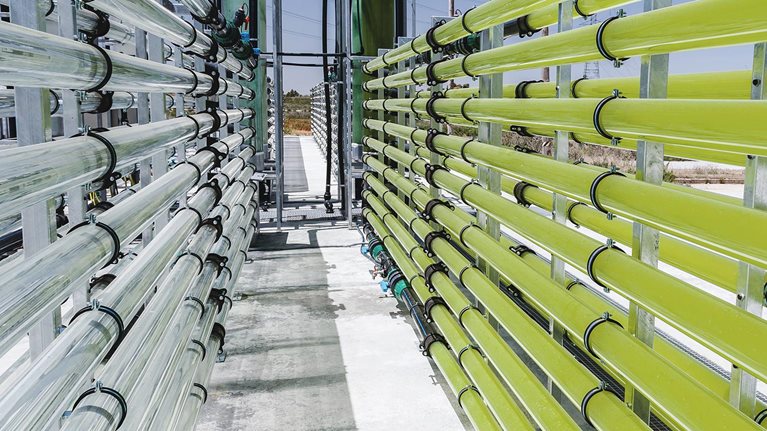To preserve a livable planet for ourselves, for our children, and for future generations, we need to successfully navigate the transformation to a climate-neutral world within the next 25 years. This transformation to a sustainable society is a joint, global challenge and an imperative for policy makers, the business community, and each and every one of us.
Our research shows that we can do it in a socially balanced way and—viewed over the full period and across all sectors—at net-zero cost,1 provided we take decisive action now. The stakes are high: failure to reach the climate targets would mean exposure to significantly higher climate risks, and a “disorderly” transition to net zero would entail significantly higher socioeconomic costs than an orderly one. The next ten years will be crucial.
After setting bold climate targets last year (a reduction in emissions by 55 percent below 1990 levels by 2030, and climate neutrality by 2050), in July the EU Commission proposed its first major package of measures to achieve this goal: “Fit for 55.” Before it recessed for the summer, the German Bundestag—following a watershed ruling by the Federal Constitutional Court—passed a new edition of the Climate Protection Act, which sets out the national goal of reaching climate neutrality by 2045. As a milestone on the way to the final goal, greenhouse-gas emissions are to be reduced by at least 65 percent by 2030 compared with 1990 levels.
As a major European economy with a large share of industry, reaching climate neutrality is a daunting endeavor for Germany (Exhibit 1). Achieving the net-zero goal requires achieving a complex technological and societal transformation on an ambitious time line: value chains have to be restructured, the power-sector transformation has to be further accelerated, we need to transition to emissions-free mobility, and we need to build and adapt the critical infrastructure before the end of the decade. In practice, the path to climate neutrality is unlikely to be linear. This is true for Germany as well as for any other country. At times, it will be necessary to backtrack and return to the drawing board. Therefore, quick and decisive action is essential—the longer we delay, the greater the cost and severity of the additional measures that would then be necessary to still hit the net-zero target.

Compared with other countries, Germany’s starting conditions are excellent, and its net-zero transition will have an impact far beyond its borders. Even if Germany cannot accomplish the global transformation to a climate-neutral world on its own, it has to play its part and set a good example as one of the leading export-oriented economies, as well as help pioneer the required new technologies and incubate new business models.
Our research shows that on a cost-optimal pathway, the transformation to net-zero emissions can be achieved at net-zero cost for society as a whole (on aggregate over the entire period and across all sectors) and in a socially balanced way—delivering a favorable business case for Germany and a leap to a new technological age. To reach climate neutrality, it is imperative to back up Germany’s net-zero ambition with concrete and commensurate actions. Germany has to tackle key challenges and actions through 2045 in the five most emissions-intensive sectors: energy, industry, transportation, buildings, and agriculture.
Substantial investments in physical assets are needed to achieve climate neutrality in Germany by 2045. Our analyses show that the total investments in physical assets required for the transition to climate neutrality includes additional investments of €1 trillion and a redirection of investments of €5 trillion. The latter are investments that have to be made in any event to replace aging infrastructure, equipment, and buildings but would be redirected to zero-emissions assets when the time comes for the scheduled replacement of assets, for instance, favoring vehicles with electric drives rather than combustion engines. The total investment volume of €6 trillion equates to an average annual investment of roughly €240 billion through 2045 or about 7 percent of Germany’s GDP2—of which €40 billion per year would be additional investments (or about 1 percent of GDP).
If we stay on the cost-optimal path, cumulative operating cost savings can offset the additional investments required. The reason is that investments in new technologies can lead to an array of improvements in operating costs, among them the energy cost of buildings or the fuel and maintenance costs of vehicles. What’s more, Germany would benefit from a strengthened position as an industrial hub as well as from the creation of new jobs. If the transformation is achieved successfully and in a timely way, Germany will be able to maintain and build out its technological leadership in critical export-oriented sectors and secure their contribution to domestic employment and prosperity. This concerns as much as 20 percent of jobs in Germany and up to 25 percent of GDP in energy-intensive trade-exposed sectors. At the same time, the transition would lead to structural shifts in employment, for example, from thermal-power generation to hydrogen production or from combustion-engine manufacturing to battery production. Overall, employment is expected to increase, for instance, driven by greater renovation activity and the installation of heat pumps in the building sector or the manufacture and installation of solar- and wind-power capacity (Exhibit 2).

Should Germany, however, fail to create the right framework conditions for the transformation in a timely manner, German companies could lose market share and, in turn, jobs and prosperity. Moreover, in such an event, a significant increase in costs can be expected, especially for basic needs such as energy, housing, and mobility. For instance, an insufficient expansion of solar and wind power could lead to a shortfall in clean electricity for the production of green hydrogen or the electrification of industrial processes, necessitating in turn the adoption of more costly countermeasures, such as carbon capture and storage. So the longer Germany needs to accelerate on the path to climate neutrality, the costlier and less socially balanced it will be.
The next decade is decisive
The next ten years will determine whether Germany is able to achieve the transition to climate neutrality and capture the economic opportunities it creates. Consistent and speedy implementation of the required measures has to be the top priority. The preconditions have never been better—countries and international communities are agreeing on climate goals, investors are shifting their capital into climate-conscious portfolios, companies are voluntarily committing to reducing their emissions, and a majority of citizens favor the move toward sustainability and increasingly choose to buy sustainable products. It is now time to follow up on commitments with clear actions. Renewable energy and infrastructure must be expanded faster, production and sales of electric cars rapidly ramped up, and industrial processes electrified or converted to biogas. There is plenty of green capital available; the main barrier is rather the complex realignment that is required of entire industries and supply chains.
The rate of change has to be increased threefold over the next ten years compared with the last 30—with a tenfold increase in some sectors—in order to achieve the required system transformations (Exhibit 3). A look at the energy and transportation sectors—just two examples—illustrates the scale of the task at hand; challenges of a similar magnitude also arise in all of the other sectors, as explained in the report:

- In the energy sector, which currently accounts for 32 percent of all emissions in Germany,3 the annual expansion of renewable energy has to exceed the figure for 2020 roughly threefold over the next ten years—between 15 and 20 gigawatts of capacity have to be added annually, partly because the electrification of industrial processes and mobility will lead to additional power demand. Furthermore, the grid infrastructure has to be expanded massively and at a far faster pace than is the case at present. And we need a “smarter” grid that enables, for example, ramping up charging of electric cars whenever renewable energy is in ample supply. At the same time, the ramp-up of cost-effective production and the import of green hydrogen and the corresponding infrastructure are essential to decarbonize industrial processes and to provide storage capacity for green energy.
- In transportation, which accounts for 20 percent of total emissions in Germany,4 the transition to e-mobility is in full swing. However, the share of electric vehicles in Germany has to increase from 6.7 percent of new registrations in 2020 (in addition to 6.9 percent plug-in hybrids)5 to roughly 60 percent of new registrations in 2030 to meet the new targets set by the European Union. That said, achieving climate neutrality by 2045 will require even more ambitious targets—our models show that, by 2030, more than three-quarters of new vehicles registered annually will have to be electric—roughly a tenfold increase on 2020 registration numbers.6 The industry is making good progress: in June 2021, it had already achieved a significant year-on-year increase, with electric cars making up 12.2 percent of new registrations (in addition to 11.4 percent for plug-in hybrids).7 Key enablers and drivers for the required massive shift include the (climate-neutral) construction of battery plants and a huge expansion of charging infrastructure.
To master the transformation, ten core actions will be decisive
- massively accelerate the expansion of renewable energy generation
- expand the energy grid (~25 percent expansion of the power-transmission grid) and increase its flexibility
- decarbonize the basic materials industry through innovations in processes and production technology
- drive the accelerated build-out of cleantech enablers: hydrogen production and transportation, battery plants, charging infrastructure, and recycling
- transition to 100 percent zero-emissions mobility
- Improve resource productivity by establishing smart and shared mobility
- modernize the heating systems of building stock (more than 50 percent heat pumps)
- develop promising key technologies for resilient and sustainable agriculture
- accelerate the trend toward healthy eating and sustainable consumer behavior
- finance and support the net-zero transformation by developing a green portfolio
In addition to these core initiatives, a number of important enablers and framework elements will be required, such as the streamlining of permitting procedures, especially for the expansion of solar and wind power and the designation of areas for urgently needed additional infrastructure, as well as the accelerated education and training of decarbonization experts in the various sectors. This is imperative to drive implementation across the board and at all levels, from entrepreneurs and decision makers to skilled workers and trainees, all of whom have a role to play. Furthermore, all these measures are dependent on bold and committed decision makers and broad citizen support.
As engines of innovation and industrialization, companies in Germany have a pivotal role to play in developing, testing, and scaling green technologies. Many German companies have already set out on the path to net zero—defined sustainability strategies, identified ways to decarbonize, and examined their portfolios, production operations, and supply chains to find opportunities to align with the net-zero transition. Many companies are well along the transformation process, but the challenge is complex: they need to invest in transforming their facilities and their value chains end to end, identify the demands on their workforce, and prepare for the transformation, a task of enormous proportions. Germany’s automotive industry is setting a good example. All OEMs have set themselves ambitious targets, with some manufacturers aiming to build net-zero electric vehicles as early as 2030. In doing so, they have set in motion the transformation of entire value chains toward the adoption of sustainable technologies.
At the same time, the green transformation offers companies the opportunity to capture future markets. A sustainable product portfolio and technological innovations offer new growth opportunities. This is true in both the consumer-goods industry, where sustainable products deliver both significantly higher growth and significantly wider margins, and in the capital-goods sector, where players are looking ahead to a period of growth fueled by the accelerated expansion of infrastructure and the restructuring of value chains. Leading sustainability oriented companies often benefit from attractive valuations that are otherwise only reached by technology companies (with some reaching EBITDA multiples of between 15 and 30). This makes it easier for them to raise capital to invest in further green growth and to scale faster. Government stimulus packages and a growing “green capital market” are providing additional tailwinds. The key to business success lies in quickly recognizing the opportunities inherent in the transformation process and capturing the value and growth potential. In parallel, legislators have to establish the framework conditions to enable and drive a rapid transformation. Germany is currently in a good position: many of the fundamental political, technological, and financial parameters are already in place. Further concrete actions now have to be taken in the individual sectors, and the conditions created that will catalyze the required system changes. To this end, enabling reliable planning is critical—how much renewable energy will be available, when, and at what cost? Significantly accelerating the pace of change is no small challenge for policy makers and businesses. Nevertheless, it is a challenge that must be mastered if the transformation is to be achieved.
Germany’s transformation to a climate-neutral society requires enormous efforts, investments, and behavioral changes from politics, business, and also from citizens. The decade ahead is crucial: the technologies for decarbonization that are already available must be implemented at scale and speed in all sectors. But we also need to develop and scale further innovations in technologies, processes, and materials to achieve the decarbonization goals. The transformation path will be complex and extremely challenging. But it also offers significant benefits, and—for the sake of our children and future generations—failure is not an option.




